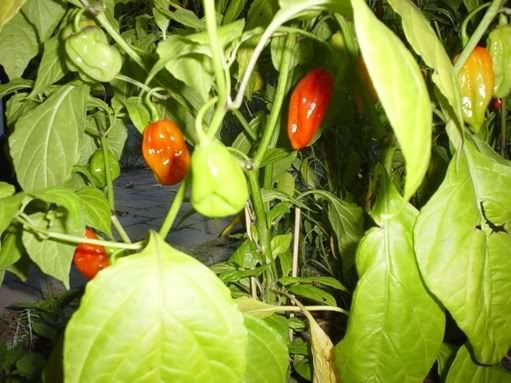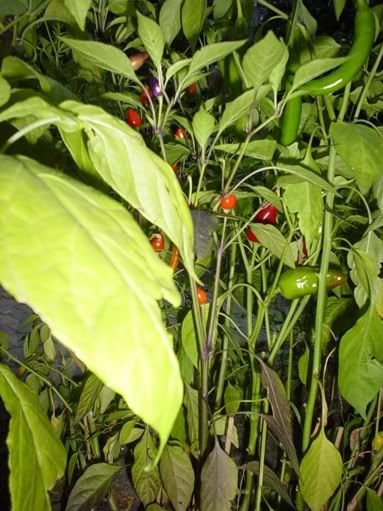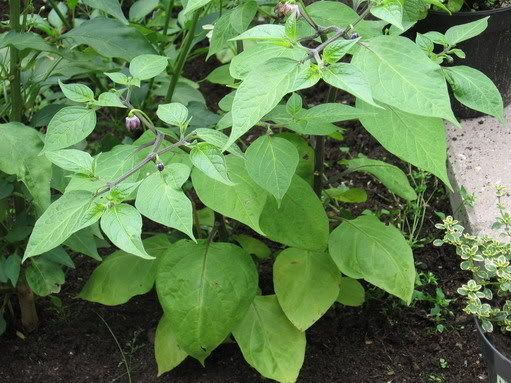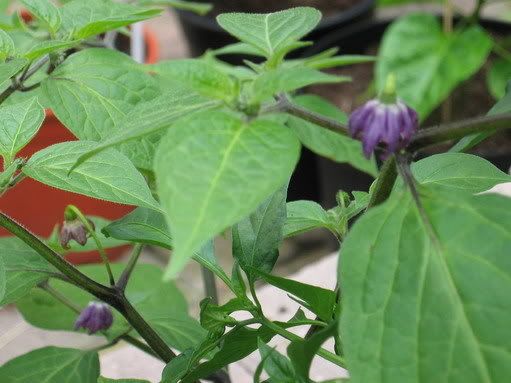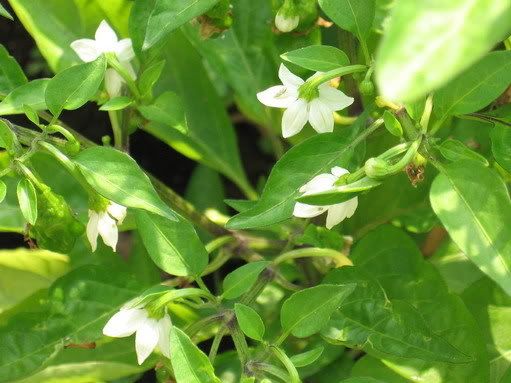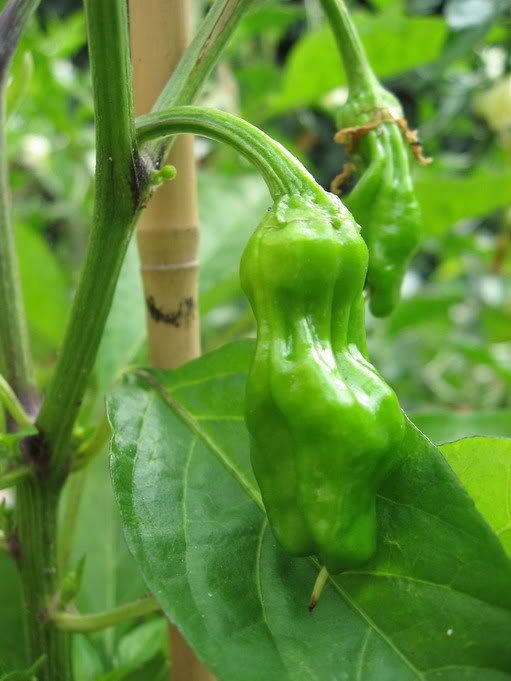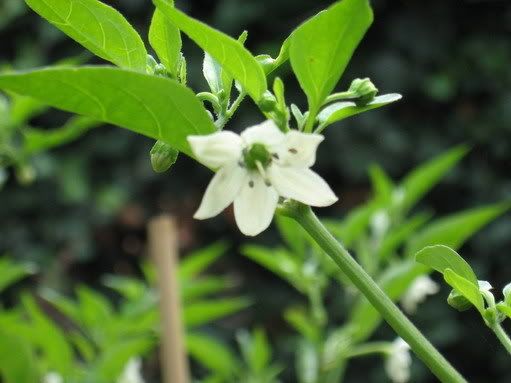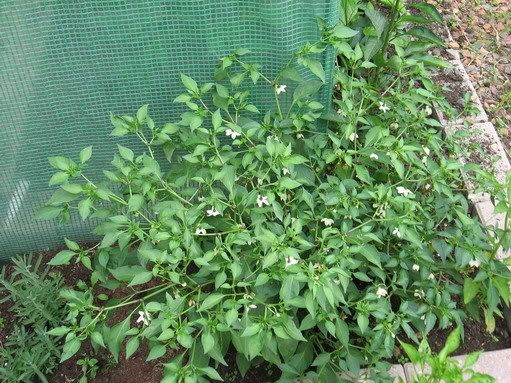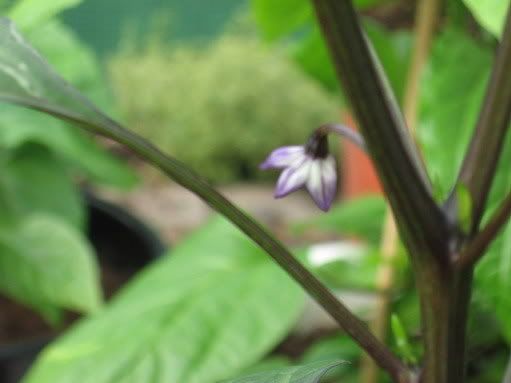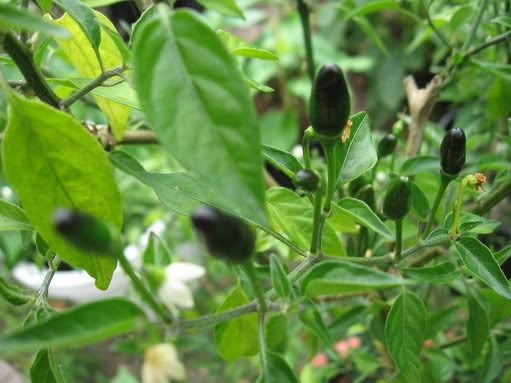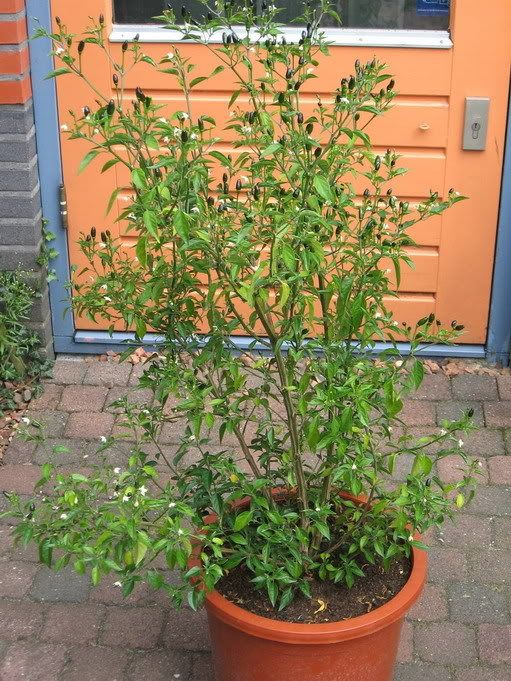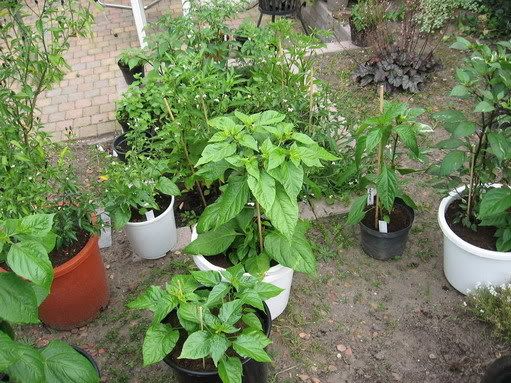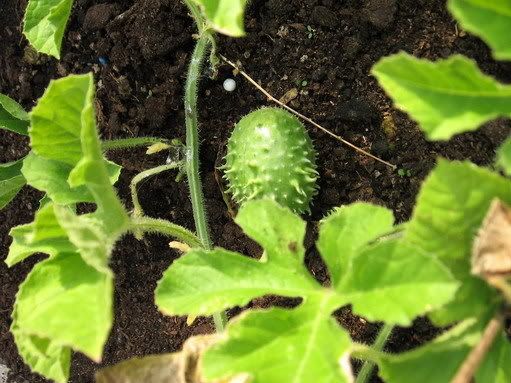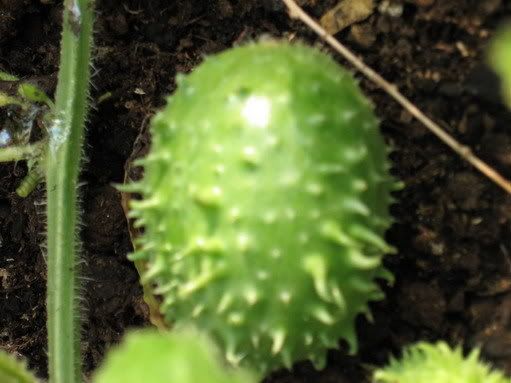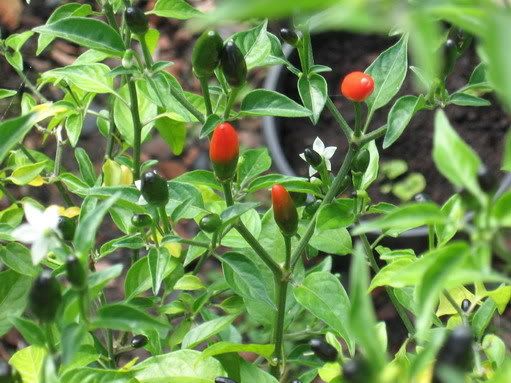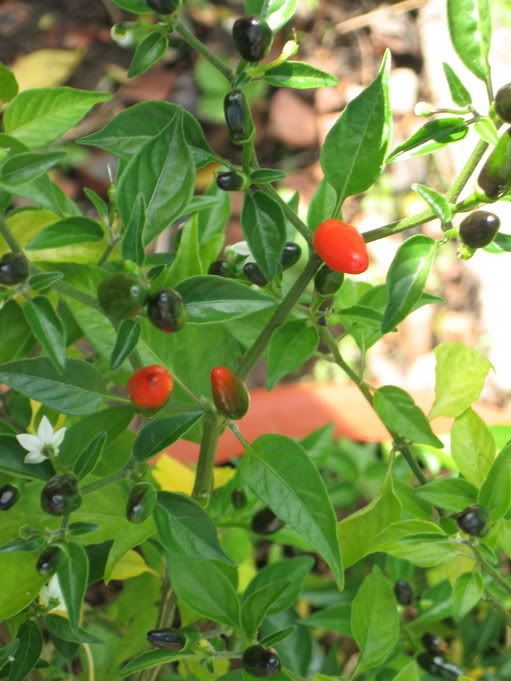F&F Flora & Fauna
Beesten in het nieuws, vragen over roerende en onroerende organismen, foto's en al het andere met betrekking op de levende have: hier kun je het kwijt...



Ik kan wel het 1 en ander vinden hier bij Fok over het kweken van pepers, maar dit onderwerp verdient een eigen Topic en dus :
Ben je ook zo'n peper-liefhebber, die zijn achtertuin ombouwt tot peper-farm ?
Kan het jou ook niet heet genoeg ?
Plaats hier dan je foto's, (kweek)verslagen, vragen, recepten of andere chilli-facts.
Er zijn heel veel (te veel om op te noemen) verschillende soorten pepers, maar deze worden in groepen ingedeeld zoals :
Annum
Baccatum
Chinense
Frutescens
Pubescens
bron :
Om de (hitte) heetheid van de verschillende soorten aan te duiden wordt er gebruik gemaakt van de "Scoville Units".
Chilli Heat: In 1902 Wibur Scoville developed a method for measuring the strength of capsicum in a given pepper, which originally meant tasting a diluted version of a pepper and giving it a value. Nowadays it can be done more accurately with the help of computers to rate the peppers in Scoville units, which indicate parts per million of capsaicin. The fiery sensation of chillis is caused by capsaicin, a potent chemical that survives both cooking and freezing, but apart from the burning sensation it also triggers the brain to produce endorphins, natural painkillers that promote a sense of well being.
The Scoville scale begins at zero with mild bell peppers and moves to the lower range of peppers measuring 1,500 to 2,500 such as cascabels, four out of ten. The Jalapeño is mid range at about 2,500 to 5,000 Scoville units. The eight out of ten chillis such as cayenne, aji and pequin will rate about 30,000 to 50,00 units, while the habernero which rates as one of the hottest comes somewhere between 100,00 and 500,000 units, but as can be seen above in the article has a hotter chilli been found ?
Chillis are easy to grow, they require minimal area and care. They will do best in warm climates or under glass with a long growing season and can be kept over winter in the right conditions. Many varieties make excellent pot plants and can be grown indoors as ornamentals although these are still edible. Be careful when growing different species close together as they will cross pollinate and produce hybrids, therefore do not keep these chilli pods for next years seeds as the required heat of the chilli may be effected by crossing with a hotter chilli.
Verder nog wat handige linkjes :
zaad nederland :
zaad :
kweken :
nice info :
more :
Ben je ook zo'n peper-liefhebber, die zijn achtertuin ombouwt tot peper-farm ?
Kan het jou ook niet heet genoeg ?
Plaats hier dan je foto's, (kweek)verslagen, vragen, recepten of andere chilli-facts.
Er zijn heel veel (te veel om op te noemen) verschillende soorten pepers, maar deze worden in groepen ingedeeld zoals :
Annum
Baccatum
Chinense
Frutescens
Pubescens
bron :
Om de (hitte) heetheid van de verschillende soorten aan te duiden wordt er gebruik gemaakt van de "Scoville Units".
Chilli Heat: In 1902 Wibur Scoville developed a method for measuring the strength of capsicum in a given pepper, which originally meant tasting a diluted version of a pepper and giving it a value. Nowadays it can be done more accurately with the help of computers to rate the peppers in Scoville units, which indicate parts per million of capsaicin. The fiery sensation of chillis is caused by capsaicin, a potent chemical that survives both cooking and freezing, but apart from the burning sensation it also triggers the brain to produce endorphins, natural painkillers that promote a sense of well being.
The Scoville scale begins at zero with mild bell peppers and moves to the lower range of peppers measuring 1,500 to 2,500 such as cascabels, four out of ten. The Jalapeño is mid range at about 2,500 to 5,000 Scoville units. The eight out of ten chillis such as cayenne, aji and pequin will rate about 30,000 to 50,00 units, while the habernero which rates as one of the hottest comes somewhere between 100,00 and 500,000 units, but as can be seen above in the article has a hotter chilli been found ?
Chillis are easy to grow, they require minimal area and care. They will do best in warm climates or under glass with a long growing season and can be kept over winter in the right conditions. Many varieties make excellent pot plants and can be grown indoors as ornamentals although these are still edible. Be careful when growing different species close together as they will cross pollinate and produce hybrids, therefore do not keep these chilli pods for next years seeds as the required heat of the chilli may be effected by crossing with a hotter chilli.
Verder nog wat handige linkjes :
zaad nederland :
zaad :
kweken :
nice info :
more :
SPOILEROm spoilers te kunnen lezen moet je zijn ingelogd. Je moet je daarvoor eerst gratis Registreren. Ook kun je spoilers niet lezen als je een ban hebt.En om dan maar zelf het spits af te bijten :
verleden jaar :
Habanero
Bolivian rainbow, Jalapeno en spaanse
Dit jaar :
op dit moment heb ik staan:
2 Ammarillo (nog geen vrucht,update later)
6 penis pepper
8 orange cayaenne (thai)
2 yellow cayenne (update volgt)
4 madamme jeanette (2 rood 2 geel)
(binnenkort)
1 varengata
1 Ajoema chocolate
(binnenkort)
1 pequin
overzicht tuin :
en ook heb ik dit jaar voor het eerst iets nieuws voor NA de peper.(vond dit bij vreeken.nl) :
KOMKOMMER OERAUGURKJE 'West India(n) Burr Gherkin', 25 zaden
'Concombre des Antilles' Een heerlijke (en gezonde!) snack tussendoor. Afkomstig uit Afrika, komt dit vruchtje in de 17e eeuw naar Jamaica en van daaruit vindt het zijn weg over Noord en Zuid Amerika. De jonge vruchtjes zijn heerlijk fris snoepgoed en wordt al eeuwenlang gebruikt als 'blusmiddel' na een hapje peper. De planten geven een enorme oogst. Rijpe vruchtjes zijn 5 cm, rond tot ovaal, vol zachte stekels. In dit stadium bijzonder sierlijk, in Brazilië zijn rijpe vruchtjes een onderdeel van de maxixada-soep.
en zo zien ze eruit :
[ Bericht 0% gewijzigd door senesta op 26-09-2007 21:10:23 ]If you can't fix it, fuck it


Wat leuk!
Zijn het allemaal éénjarige planten?
Zijn het allemaal éénjarige planten?
JoOlz: "So much good shit in senesta's head, I call it Ideahhrea."


Ja de meeste wel , maar de Pequin en de tepin heb ik nu voor het 2de jaar staan. Ze hebben de overwintering overleeft, en zijn daarom veel eerder gaan bloeien.quote:Op dinsdag 14 augustus 2007 23:05 schreef senesta het volgende:
Wat leuk!
Zijn het allemaal éénjarige planten?
Foto's van de tepin (plant) komen nog. (deze is 1.30 meter)
If you can't fix it, fuck it


Het was ook een hele zachte winter natuurlijk, overleven ze strengere vorst ook?
JoOlz: "So much good shit in senesta's head, I call it Ideahhrea."


Mooie planten, maar gebruik je zoveel peper in de keuken of is het gewoon voor de leuk?
I don't like your jerk-off name. I don't like your jerk-off face. I don't like your jerk-off behavior, and I don't like you, jerk-off. Do I make myself clear?


NEE ze hebben een constante temp nodig van rond de 15 a 20 graden.quote:Op dinsdag 14 augustus 2007 23:11 schreef senesta het volgende:
Het was ook een hele zachte winter natuurlijk, overleven ze strengere vorst ook?
Binnen zetten dus.
Maar dit jaar heb ik een soort uit india (amarillo) en die kan 5 graden vorst wel aan.
Ik gebruik wel erg veel peper ja, er zijn ook zoveel dingen mee te doen : eten kruiden, sauzen, sambal en op zuur zetten. Kortom ik bespaar mezelf zo behoorlijk wat geld uit (supermarkt-prijzen zijn belachelijk) en zo kom je ook makkelijk aan soorten die je dus nergens kunt krijgen. (hier zijn over het algemeen alleen maar de spaanse te krijgen)quote:Op dinsdag 14 augustus 2007 23:12 schreef Serendips het volgende:
Mooie planten, maar gebruik je zoveel peper in de keuken of is het gewoon voor de leuk?
vandaar
If you can't fix it, fuck it


En het is natuurlijk kei-leuk en het zijn erg mooie planten (vind ik dan ) en.... en....
If you can't fix it, fuck it


Jalapenos en habaneros.
Dit is enkele maanden geleden.
Status een week geleden:
De Habaneros zijn nog erg klein maar krijgen wel al een berg bloemetjes.
Al mijn jalapenos hebben hebben ondertussen bloemetjes en/of pepertjes in de groei.
Voor de habaneros is het gewoon niet warm genoeg geweest.
Dit is enkele maanden geleden.
Status een week geleden:
De Habaneros zijn nog erg klein maar krijgen wel al een berg bloemetjes.
Al mijn jalapenos hebben hebben ondertussen bloemetjes en/of pepertjes in de groei.
Voor de habaneros is het gewoon niet warm genoeg geweest.
- "Autisten met elkaar in contact brengen is net zoals delen door 0"


Leuk! Volgend jaar wil ik er ook wat in de tuin zetten. Dit jaar was ik te laat. Achteraf had het ook niet zo veel zin gehad denk ik, aangezien we nog niet echt een zomer hebben gehad.
Ik heb wel een paar (punt)paprikaplanten, waar vruchten aan zitten. Hoewel ze familie zijn van de peper horen ze hier niet echt thuis lijkt me.
Ik heb wel een paar (punt)paprikaplanten, waar vruchten aan zitten. Hoewel ze familie zijn van de peper horen ze hier niet echt thuis lijkt me.
Suiker en melk is voor mensen die geen koffie lusten


ziet er netjes uit hoor, maar ik zou (als ik jou was), de pepers wat grotere potten geven, kan je er gelijk wat tomatenmest bij doen voor een betere productie.(en evt bloedmeel ivm met stikstof tekort).quote:Op woensdag 15 augustus 2007 00:01 schreef Nembrionic het volgende:
Jalapenos en habaneros.
Dit is enkele maanden geleden.
[afbeelding]
[afbeelding]
Status een week geleden:
[afbeelding]
[afbeelding]
[afbeelding]
De Habaneros zijn nog erg klein maar krijgen wel al een berg bloemetjes.
Al mijn jalapenos hebben hebben ondertussen bloemetjes en/of pepertjes in de groei.
Voor de habaneros is het gewoon niet warm genoeg geweest.
Als strax je jalapeno's gaan afrijpen, kijk dan niet raar op van de "droogscheuren" in de pepers, er komen dan allemaal bruine aders over te lopen, dit is (kwam ik later achter) echter heel normaal voor deze soort.
voor strax alvast .... EET SMAKELIJK
If you can't fix it, fuck it


Ze staan reeds in grote pottenquote:Op woensdag 15 augustus 2007 14:01 schreef THCees het volgende:
[..]
ziet er netjes uit hoor, maar ik zou (als ik jou was), de pepers wat grotere potten geven, kan je er gelijk wat tomatenmest bij doen voor een betere productie.(en evt bloedmeel ivm met stikstof tekort).
Als strax je jalapeno's gaan afrijpen, kijk dan niet raar op van de "droogscheuren" in de pepers, er komen dan allemaal bruine aders over te lopen, dit is (kwam ik later achter) echter heel normaal voor deze soort.
voor strax alvast .... EET SMAKELIJK
- "Autisten met elkaar in contact brengen is net zoals delen door 0"


er is altijd de mogelijkheid om ze binnen te laten groeien, mits er gebruik wordt gemaakt van een TL, om de lichturen te vergroten.quote:Op woensdag 15 augustus 2007 09:12 schreef NT-T.BartMan het volgende:
tvp. Nu is het te laat, maar volgend jaar wil ik ook een poging doen!
Als je dus nu nog wilt zaaien kan dat wel maar dan zal ze op de vensterbank moeten laten afbloeien.
Met als gevolg dat je ze heel vroeg weer buiten kan zetten het volgende jaar, en dus zo weer een grotere peper productie krijgt.
If you can't fix it, fuck it


hehe pepers als kattevoerquote:Op woensdag 15 augustus 2007 09:35 schreef Lotjeb het volgende:
Wat leuk! Ik was ook bezig maar een van mijn katten heeft alle plantjes opgegeten
Volgend jaar een nieuwe poging
If you can't fix it, fuck it


Mijn katten hebben vorig jaar m'n paprika's opgegeten toen ze net bovenkwamen, maar de pepers (zaadjes uit een rood pepertje van de supermarkt) hebben ze dit jaar met rust gelaten. Ik heb twee peperplantjes gehouden en toen ze wat groter waren begon één van de katten er ineens van te vreten. (ik weet ook gelijk wanneer hij er weer aangezeten heeft want dan gaat 'ie aan de dunne). Aan beide plantjes is maar één pepertje gekomen, ze moeten alleen nog rood worden.


Laten we nou eens net doen of mijn vingers nét groen genoeg zijn om een zaadje in de grond te stoppen...quote:Op woensdag 15 augustus 2007 14:05 schreef THCees het volgende:
[..]
er is altijd de mogelijkheid om ze binnen te laten groeien, mits er gebruik wordt gemaakt van een TL, om de lichturen te vergroten.
Als je dus nu nog wilt zaaien kan dat wel maar dan zal ze op de vensterbank moeten laten afbloeien.
Met als gevolg dat je ze heel vroeg weer buiten kan zetten het volgende jaar, en dus zo weer een grotere peper productie krijgt.
Afbloeien?? Wasda?
Ik zou overigens een potje op mijn kantoor kunnen zetten, daar brandt 12 uur per dag een TL. Het is er door de airco alleen niet zo heel warm. Zou dat gaan werken?


*In een spontane bui een tijd geleden een paar zaadjes van een c1000 peper van de avondmaaltijd gered en in potjes gedaan* TVP
De eerste bloemetjes hangen er ondertussen in.
De eerste bloemetjes hangen er ondertussen in.
Egregious professor of Cruel and Unusual Geography
Onikaan ni ov dovah
Onikaan ni ov dovah


haha nou dan ben je inderdaad niet echt de aangewezen persoon om daarmee te gaan expirimenteren.quote:Op woensdag 15 augustus 2007 15:09 schreef NT-T.BartMan het volgende:
[..]
Laten we nou eens net doen of mijn vingers nét groen genoeg zijn om een zaadje in de grond te stoppen...
Afbloeien?? Wasda?
Ik zou overigens een potje op mijn kantoor kunnen zetten, daar brandt 12 uur per dag een TL. Het is er door de airco alleen niet zo heel warm. Zou dat gaan werken?
(afbloeien is de fase van groei naar bloei)
En da idee op kantoor ?, een plant heeft om te groeien 18 uur of meer zonlicht nodig, dus ook een dikke nee voor dat verhaal.
Er zit dan nix anders op dan te wachten tot februari- maart, en ze dan binnen uit te zaaien, om ze dan vervolgens eind mei weer naar buiten te zetten.
If you can't fix it, fuck it


Pas sinds een week of 2 heb ik piepkleine pepertjes aan mijn jalopena planten zitten.
Ik verlies heel veel bloemetjes.
Wat die ik fout?
Ik verlies heel veel bloemetjes.
Wat die ik fout?


Wat bedoel je met "bloemen verliezen"?quote:Op woensdag 15 augustus 2007 20:51 schreef Thorical het volgende:
Pas sinds een week of 2 heb ik piepkleine pepertjes aan mijn jalopena planten zitten.
Ik verlies heel veel bloemetjes.
Wat die ik fout?
Dat ze eraf vallen? Of dat er geen pepertjes aankomen?
Staan ze binnen? Staan ze buiten?
Als de bloemetje gewoon geen pepers geven moet je er af en toe even zachtjes tegenaan tikken of met een fijn penseel heel lichtjes de binnenkant beroeren. Het kan zijn dat het stuifmeel niet op de stempel komt.
Als je er tegenaan tikt en je zit een beetje poeder vallen dan moet het wel gelukt zijn
-edit- waar heb je het zaad vandaan? Echt een zakje zaad gekocht of zaadjes uit een pepertje?
- "Autisten met elkaar in contact brengen is net zoals delen door 0"


Wat veel vragen.quote:Op woensdag 15 augustus 2007 21:07 schreef Nembrionic het volgende:
[..]
Wat bedoel je met "bloemen verliezen"?
Dat ze eraf vallen? Of dat er geen pepertjes aankomen?
Staan ze binnen? Staan ze buiten?
Als de bloemetje gewoon geen pepers geven moet je er af en toe even zachtjes tegenaan tikken of met een fijn penseel heel lichtjes de binnenkant beroeren. Het kan zijn dat het stuifmeel niet op de stempel komt.
Als je er tegenaan tikt en je zit een beetje poeder vallen dan moet het wel gelukt zijn
-edit- waar heb je het zaad vandaan? Echt een zakje zaad gekocht of zaadjes uit een pepertje?
De zaadjes zijn gekocht bij de intratuin. (met kiem garantie, weleenswaar een jaar geleden maar ook ditjaar zijn alle zaadjes opgekomen)
De plantjes staan in 24cm potten op mijn balconnetje.
En de bloemmetjes vallen er spontaan af. Veel vaker dan vorig jaar.
Het bestuiven met een penseeltje heb ik wel eens gedaan maar nu moeten de beestjes het maar eens doen.


dat de bloemetjes afvallen is op zich goed (hierna zal de peper zich gaan ontwikkelen), alleen als het bloemtje met een stukje steel eraan afvalt of geel wordt is het waarschijnlijk niet bevrucht en valt ze af.quote:Op donderdag 16 augustus 2007 12:55 schreef Thorical het volgende:
[..]
Wat veel vragen.
De zaadjes zijn gekocht bij de intratuin. (met kiem garantie, weleenswaar een jaar geleden maar ook ditjaar zijn alle zaadjes opgekomen)
De plantjes staan in 24cm potten op mijn balconnetje.
En de bloemmetjes vallen er spontaan af. Veel vaker dan vorig jaar.
Het bestuiven met een penseeltje heb ik wel eens gedaan maar nu moeten de beestjes het maar eens doen.
en inderdaad de beestjes kunnen dat als geen ander
If you can't fix it, fuck it


update :
In 2 dagen tijd begint de Pequin (pilli pilli) rood af te rijpen. (en dat met zo'n k*t zomer)
Nu maar hopen op een beetje warme nazomer
kijk das een mooi plaatje ::
[ Bericht 2% gewijzigd door THCees op 17-08-2007 20:22:09 ]
In 2 dagen tijd begint de Pequin (pilli pilli) rood af te rijpen. (en dat met zo'n k*t zomer)
Nu maar hopen op een beetje warme nazomer
kijk das een mooi plaatje ::
[ Bericht 2% gewijzigd door THCees op 17-08-2007 20:22:09 ]
If you can't fix it, fuck it


Kees, het brand op m'n ogen zo mooi zijn je pepers.
Maar wat is dat nou tomatenmest, voor een betere productie.(en evt bloedmeel ivm met stikstof tekort).
Tomatenmest waar koop je het, hoe verzinnen ze het? En bloedmeel doet me denken aan het kweken van groeneplantjes die in rook opgaan.
Maar wat is dat nou tomatenmest, voor een betere productie.(en evt bloedmeel ivm met stikstof tekort).
Tomatenmest waar koop je het, hoe verzinnen ze het? En bloedmeel doet me denken aan het kweken van groeneplantjes die in rook opgaan.
|
|
| Forum Opties | |
|---|---|
| Forumhop: | |
| Hop naar: | |

 developed a method for measuring the strength of capsicum in a given pepper, which originally meant tasting a diluted version of a pepper and giving it a value. Nowadays it can be done more accurately with the help of computers to rate the peppers in Scoville units, which indicate parts per million of capsaicin. The fiery sensation of chillis is caused by capsaicin, a potent chemical that survives both cooking and freezing, but apart from the burning sensation it also triggers the brain to produce endorphins, natural painkillers that promote a sense of well being.
developed a method for measuring the strength of capsicum in a given pepper, which originally meant tasting a diluted version of a pepper and giving it a value. Nowadays it can be done more accurately with the help of computers to rate the peppers in Scoville units, which indicate parts per million of capsaicin. The fiery sensation of chillis is caused by capsaicin, a potent chemical that survives both cooking and freezing, but apart from the burning sensation it also triggers the brain to produce endorphins, natural painkillers that promote a sense of well being.